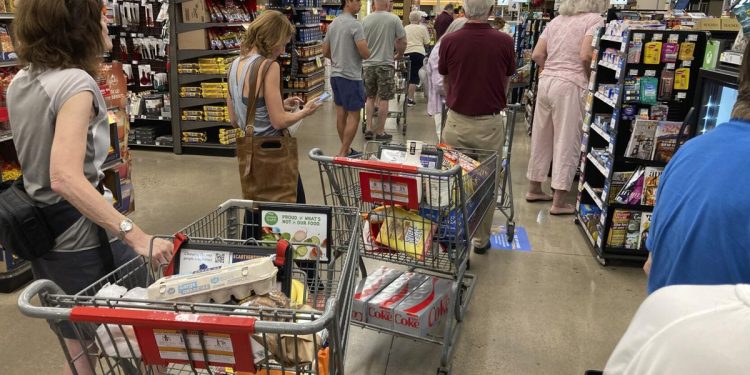By Casey Harper | The Center Square
(The Center Square) – Food and gas prices continue to rise, putting a strain on Americans’ budgets even as reports shows inflation is slowing.
Gas prices have risen significantly in recent weeks, according to pricing data from AAA. Gas prices hit a record high earlier in the Biden administration, surpassing an average of $5 per gallon nationally, before dropping back down.
Now they are rising again, currently at $3.85 per gallon of regular gas, up from $3.82 a week ago and $3.57 a month ago. In the last month, diesel prices have risen from $3.86 per gallon to $4.13 per gallon.
Food prices have risen as well. The U.S. Bureau of Labor Statistics last week released its Consumer Price Index and Producer Price Index, two key markers of inflation that showed prices rose less than half a percentage point last month.
The CPI rose 3.2% in the last 12 months, and the PPI rose 0.8% over the same period, higher than expected.
These rates have slowed from the rapid pace earlier in the Biden administration, but some food products have seen price increases that outpace the average inflationary rate.
Overall, grocery prices have risen much faster than the average rate of inflation for years.
The CPI for all urban consumers averages the cost increases for American cities, and many common household food items doubled or tripled the average CPI increase.
For instance, white bread rose 10.7% from July of 2022 to July of 2023.
- Cereal and bakery products rose 7%
- Cookies rose 7.9%
- Breakfast cereal rose 5.1%
- Rice rose 6.1%
- Frozen and refrigerated bakery products, pies, tarts, turnovers rose 8%
- Raw beef steaks rose 7.8%
- Raw roasts rose 6.3%
- Crackers, bread, and cracker products rose 8.2%
- Ice cream and related products rose 6.3%
- Frozen vegetables rose 17.1%
- Nonalcoholic beverages and beverage materials rose 5.4%
- Margarine rose 11.3%
- Salad dressing rose 9.2%
- Baby food and formula rose 5.9%
Some other products such as pork and chicken decreased in cost, 3.7% and 2.5% respectively in the same 12-month period.
Ryan Young, senior economist, Competitive Enterprise Institute, told The Center Square that some of the price hikes Americans are facing are related to money supply and spending problems while part of it also has to do with regulatory and supply chain issues.
“Inflation is cured by better money supply management,” he said. “The gas and food price hikes we’re seeing can be helped by expanding energy permitting and exploration, and by getting rid of protectionist agricultural policies and trade restrictions.”
Young also pointed to some hopeful indicators.
“Some context is also necessary,” he said. “Gas prices are going up. But they are also about 20 cents per gallon lower than they were this time last year. And the recent increases follow months of declines. As prices go up and down, and people tend to get angry at the ups while ignoring the downs, which colors the media coverage they get. And in last month’s CPI report, food prices went up slower than the overall inflation rate. Overall inflation as 0.2% during June, while food prices went up 0.1%.”
Republicans blasted the Biden administration after the latest pricing data was released, pointing to the soaring federal debt, and the money-printing that helps propel it.
“American families need relief from persistent and painful high prices,” Said Sen. John Barrasso, R-Wyo. “Joe Biden signed the Democrats’ reckless tax and spending spree into law one year ago. He claimed more spending would bring down prices. Once again, he was wrong. Prices are still going up. Americans are facing sky-high prices at the grocery store, at the gas pump, and while back-to-school shopping. They’re digging into their dwindling savings just to keep up.”
The Biden administration has pointed to relatively low unemployment and the progress made since the lockdowns during the COVID-19 pandemic.
Sen. Rick Scott, R-Fla., also took a shot at Biden after the data was released.
“This week, I have been traveling Florida to hear what issues families are facing, and in each big city or small town I stop in one thing keeps getting mentioned—inflation,” Scott said.



